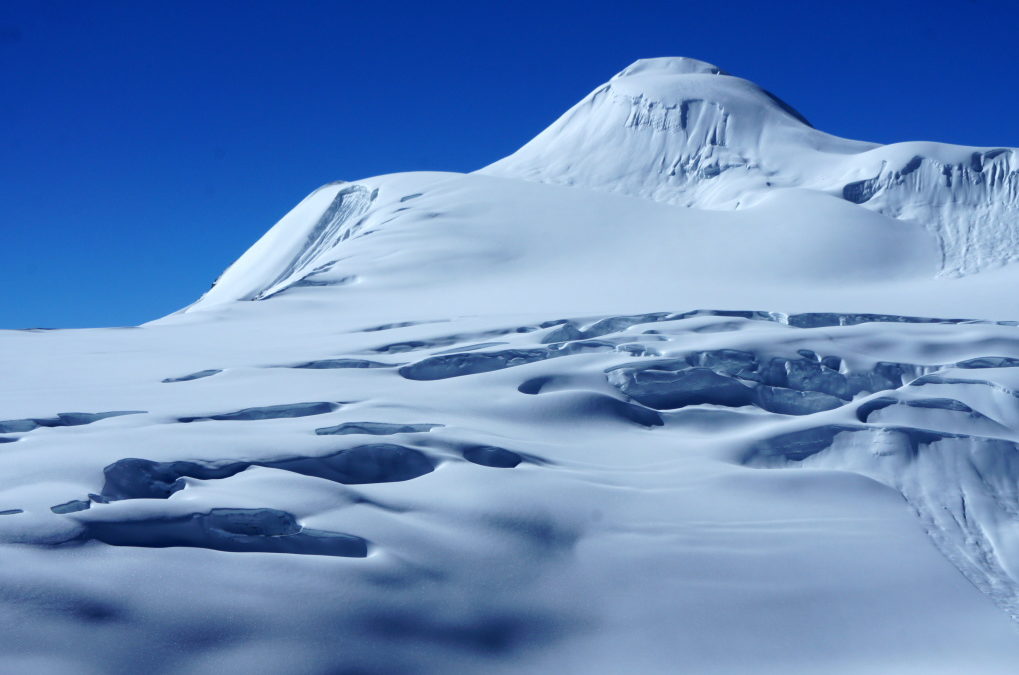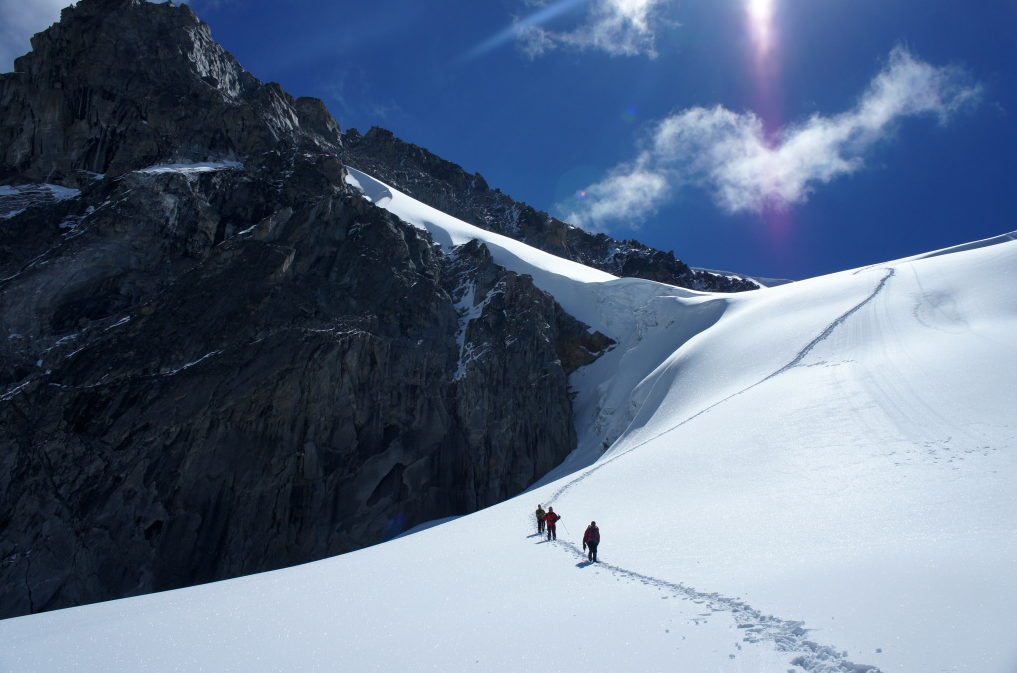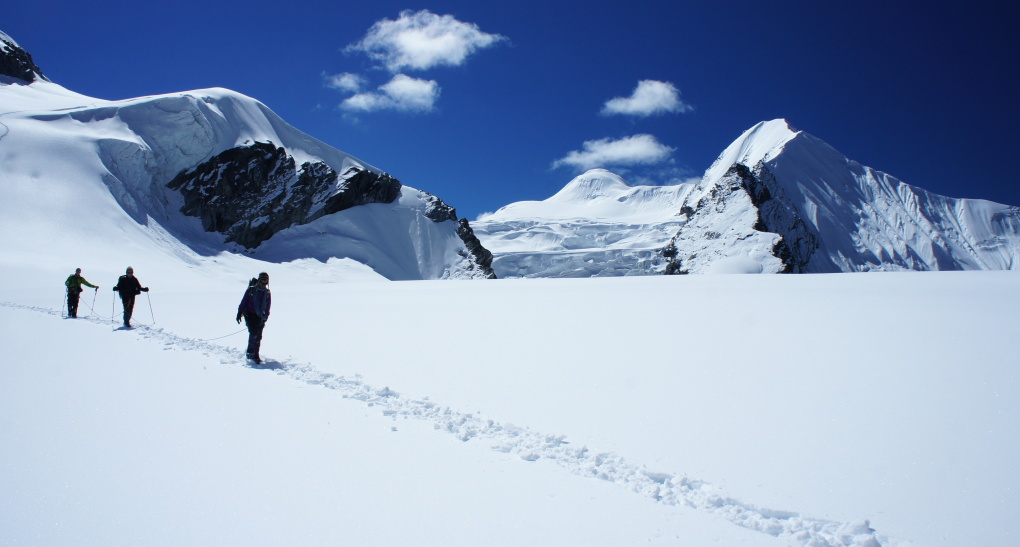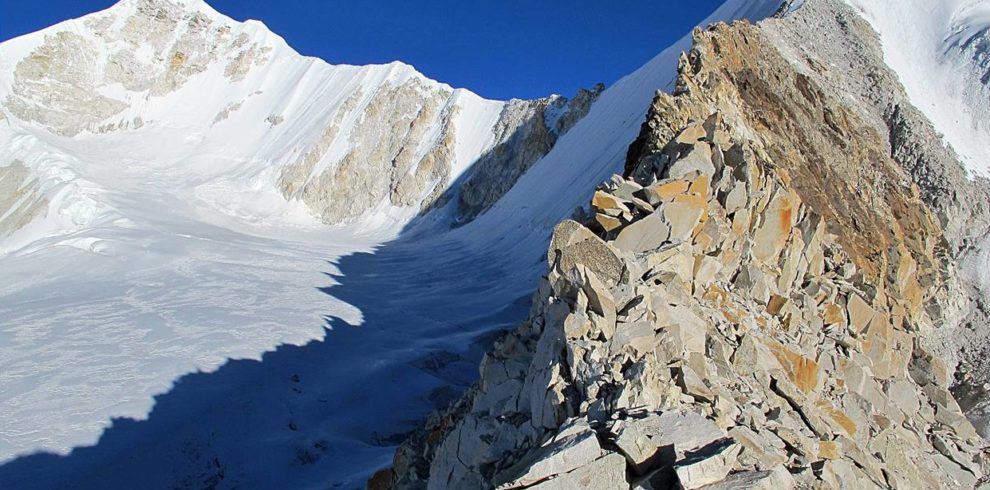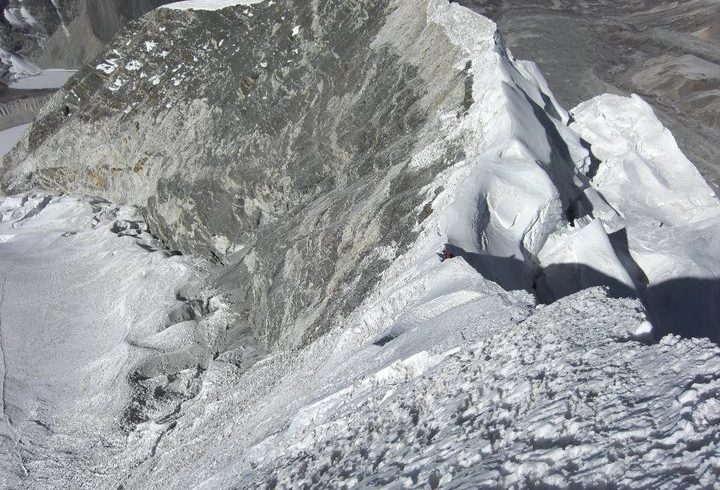Pachermo Peak Climbing lies to the south part of the Tashi Lapcha La in Rolwaling. The technical pass leads us from the Rolwaling Valley to the Khumbu region. The view seen from the Tasi Lapcha Pass, Pachermo peak provides us a spectacular range of Himalayas. Furthermore, our Pachermo Peak high camp near the Tashi Lapcha La pass stands at an altitude of 5750m. Which is in another range, straightforward snow peak with a well-defined ridge. Its rises from the relatively flat, crevassed glacier seem some more difficult.
After that cross the wide, crevassed snow slopes to gain the ridge of the Pachermo side. Also, It rises from the broken glacier of the pass bit. The ridge is followed with little difficulty, although it continues the same condition until nearby the summit. Lots of parties have reported a problematic ice step caused by a large crevasse in this climbing. It’s all about near 300 feet from the summit. So our Everest hiker team is ready to assist in this section to make a dream to been top of this Pachermo Peak Summit.
Pachermo Peak Technical and Difficulties
Pachermo Peak Climbing is not technical but needs high-level experiences. So it is a high altitude pass trek, we must have to hire experienced Sherpa guide. Everest hiker team loves to organize any trip according to your plan, ask us and lets us your idea to tailor. We are known as hidden valley operators Nepal. Adding few extra days in itinerary provides us with opportunities to explore Rolwaling Trek with Pachermo Climbing. Thus Rolwaling and Pachermo Peak are all about camping trek in Nepal. Many technical parts and overnight in above 5700m make the trip hard for even for all.
After reaching the top of the Tsilapcha Pass we need 1 more day for the Pachermo Peak expedition. After exploring Peak it is relatively easy to down. The Trek difficulties and fitness level required in the Team to achieve it. The Everest hiker Team is always there in your willingness to assist Himays to dream in reality.
Overview
Pachermo Peak (6187m)
Duration: 16 day
Grade: Challenging
Trek Type: Camping or Lodge Trek
Elevation: min. 2866m to the max. 6,187m
Trek starting/ending point: Lukla
Explore Manaslu Team has compiled a list of essential climbing equipment’s, personal medical provisions, and summary of medical items to encounter during 8000m expeditions. And to help climbers in preparation and provisioning for a mountaineering expedition.
This list should be considered as an essential summary for expeditions. Embarking on the adventure are encouraged to conduct further study and practical exercises to familiarize themselves with the equipment, medical terminology, and others more. Understanding of medical conditions that related to the high elevation, cold, wind, excessive sun radiation as well as injuries likely to sustain in the outdoor situation.
Essential Personal Climbing Gear:
• Alpine Harness: Climbing Harness should be light and simple in design, easily can put on and take off with gloves on, with positively foolproof locking features.
• Crampons: Crampons are perfectly fit to boots; steel crampons with anti-balling and ability to toe point positively and safely into ice.
• Ice ax: Ice ax should be latest versatile with light for general purpose.
• Ascender: Ascender or Jamar, a mechanical device used for ascending on a rope; must be suitable to be used while gloves or mittens.
• Multi-LED Head Lamp: High-quality Multi-LED Head Lamp with spare batteries is essential, we do not recommend single bulb lights due to its low reliability and a single point of failure.
• Karabiners: Minimum 2 locking carabineers, 1 large and 1 small and 4 regulars.
• Rappel device: Figure 8, ACT or similar; be familiar with Munter Hitch as it may save your life if you lose your Rappel device and you will at some stage
• Ski poles: Very handy and familiar for adjustable types are the best and are recommended
• Slings: Must be one 3m (10ft) and other three 2m (6ft).
• Masks, hoses, and regulators: Good quality for your safety.
• Altimeter :
• Climbing helmet: Climbing lightweight helmet is essential safety gear for crossing areas under rocks and ice cliffs.
Clothing
For undergarments items, we recommend you to used Merino Wool from Icebreaker because the company develop according to climbers and mountaineers needs and utilizes with the best quality. They are a superior company and export Icebreaker quality. Quality clothes are essential for your comfort and safety. Merino wool is the finest wool. And it matches cotton softness and polypropylene with insulation and breath-ability because it takes moisture away from the body and keeps you dry and warm. It has natural nano-tube construction with antibacterial properties, so it stays usable for longer. It is slightly more expensive than polypropylene so it is suitable for expedition and trekking.
Upper Body:
• One T-shirt Icebreaker Merino around 150 or light one 200.
• Two extended Icebreaker Merino around 150 or lightweight 200 shirts.
• One polar fleece pullovers in medium weight.
• One polar fleece jacket.
• One Gore-Tex waterproof and breathable jacket with a large hood which should accommodate a climbing helmet.
• Lightweight down jacket for base camp or warm layer when stopping for short breaks.
• One very warm goose-down (duvet) jacket with hood or a down/duvet suit, for high altitude use.
Note: Your clothing should be dry, so bring waterproof stuff sacks, bin-liners, or large plastic bags.
Hands:
• One pair of lightweight poly-liner gloves. These will be worn when tying knots, but not inside your mitts
• One pair mittens consist of 1 Goretex over mitt matched with the hot polar fleece mitt liner
Heads:
• Warm hat wool or synthetic that covers your ears
• Balaclava
• Scarf or neck sleeve
• Face mask
• Ballcap or brimmed sun cap
• Glacier Sunglass with side shields
• One pair ski goggles (optional with light and dark lens)
• Bandana or headscarf, useful for dusty conditions
Lower Body:
• Icebreaker Merino 150 underwear briefs
• One pair of walking shorts
• One pair of walking trousers for trekking and around camp
• Two pair Icebreaker Merino 150 or lightweight 200 thermal bottoms
• One pair Icebreaker Merino around 200 weight thermal bottoms one.
• One pair of polar fleece trousers
• One pair of Gore-Tex trousers or bibs should be Waterproof/breathable with full side zips
• One pair of Goose-down (duvet) trousers or bibs. You may prefer a down (duvet)
Note: Your clothing should be dry, so bring waterproof stuff sacks, bin-liners, or large plastic bags.
Feet:
• One pair One-Sport Millet Everest Overboots or equivalent (with Aveolite liners; good quality plastic shells with inner boots; avoid tight fit with heavy socks.)
• One pair sturdy leather or synthetic (Gortex) hiking boots with good ankle support for the walk to advanced base camp
• One pair cross-trainers, running shoes and/or sandals for Kathmandu and in camp
• One pair down booties (optional)
• Two pair med-heavy poly or wool socks
• Two Pair of liner socks. Polypropylene or wool
• Vapor barrier liner socks or plastic bread-bags
• Two pair lightweight trekking socks, poly or wool
• Light Icebreaker Merino wool or cotton socks for in town.
Travel and Sleeping Gear
Rucksacks and Travel Bags:
• One medium-size rucksack (50-70 litters / 3000-4500 cubic inches, should be fit in an airplane).
• Two large (120 L / 7500 cubic inches) duffle kit bags for clothing and equipment safety. Must be durable for use on pack animals.
• Small padlocks for duffel kit bags.
Sleeping Gear:
• For high altitude, one down (duvet) sleeping bag (rated to –35 C (-30 F). In the high camp, you can sleep with your own (duvet) inside your sleeping bag.
• For base camp, one additional sleeping bag (good to -20 C (-5 F).
• At least 3 closed cell foam mats for use in base camp and high altitude, which can be purchased in Kathmandu inexpensively; we do not recommend inflatable mats due to the high probability of accidental puncture.
Note: Your clothing should be dry, so bring waterproof stuff sacks, bin-liners, or large plastic bags.
Medical
Personal Hygiene:
• Personal hygiene supplies;
• Two tubes lip sun cream, 1 large tube skin sun cream (min. factor 30);
• One toothpaste/brush set;
• 2 bar soap or hand sanitizer gel/1 small synthetic towel;
• Hand wipes.
Medical Supplies:
• Note Small personal first-aid kit. (Simple and Light) Aspirin, first-aid tape, plasters (Band-Aids), personal medications, etc. The leaders will have extensive first-aid kits,
• Personal prescription medications. Please let your leader about any medical privacy issues before the climb.
• One skin blister repair kit.
• Personal medications are inexpensively available in Kathmandu also, with doctor’s prescription may not.
• One small bottle of anti-diarrhea pills (Imodium).
• One small bottle of anti-headache pills.
• One small bottle of cough and/or cold medicine.
• One course antibiotics for a stomach infection, available locally at chemist shop or pharmacy.
• One course antibiotics for a chest infection, available locally at chemist shop or pharmacy with doctor’s prescription.
• One small bottle anti-altitude sickness pills: Diamox, Acetazolamide. For more about this medication, please contact us.
• Do not bring sleeping pills. They are harmful to a respiratory depressant in high altitude.
• One small bottle of water purification tablets or water filter.
• Earplugs.
• Extra prescription glasses/contact lens. Contact lens wearers, please bring glasses in case of emergency.
Personal Food
Our skillful cooks will prepare 3 delicious hot meals and boil plenty of drinks each day in base camp, as well as in camp 2 on the mountain. This meals will consist of soup, local cheese & sausage, biscuits, dried noodles, potatoes, rice, porridge, butter, dried and tinned vegetables, fruit, meats, and fish, tea with milk and sugar, powdered juice drink, and drinking chocolate. Our Sherpa helper will be carrying this food to the higher camps.
We ask only members to bring 5 dehydrated meals (freeze-dried dinners) for their summit attempt. On summit day you will be at high elevation and you will be affected by the altitude with minimal appetite and for a period so it is essential to have flavors you most likely will consume.
We cannot cater to specific personal and uncommon foods and flavors to the climber. If you have any unusual, non-standard or specific personal, cultural or religious dietary requirements, which can only be satisfied with the imported product, we ask you to bring your imported daily snack and energy foods on our references.
We are not able to provide “snack” food such as chocolate or “energy-bars”. We would ask you that bring or buy your own “snack” or daily cold energy food in Kathmandu or home country. From our experience 3-6 kilos/6-12 pounds is a sufficient amount for each. A growing variety of imported foods such as European and American cheeses, chocolates, biscuits, cookies, nuts, and locally made power-bars are now available in Kathmandu, at realistic prices. However, imported brands of power bars, GU, re-hydration drinks, dehydrated food, “freeze-dried meals”, imported cheese and sausage may not be available in Nepal. If you want these items, you must bring them along from a western country. Many of our members, especially Britons, Europeans, and Australians with tiny baggage allowances, now purchase their daily snacks in Kathmandu. we have enough time and schedule in Kathmandu for shopping or arranging Gear too.
Miscellaneous Practical Items:
• 1 small roll of repair tape, 1 sewing repair kit;
• 1 cigarette lighter, 1 small box matches;
• 1 compass or GPS;
• 1 battery powered alarm clock/watch;
• 1 digital camera with extra cards and extra batteries;
• Nylon stuff sacks For food and gear storage, large Ziplocs are also useful;
• 3 Water bottles (1lit) wide-mouth Nalgene (1 is a pee bottle)
• 1 plastic cup and spoon;
• 1 small folding knife;
• Binoculars (optional);
• 4 large, waterproof, disposable rubbish sacks;
• Passport, 2 extra passport photos, flight ticket, flight itinerary;
• Separate photocopies of passport and relevant visa pages, proof of insurance;
• dollars, pounds or euros cash for purchasing Nepalese visa at Kathmandu airport, Tibet visa, for paying for restaurants and hotels, for gratuities, snacks, and to purchase your drinks and gifts;
• Credit cards, Bank/ATM/Cash machine cards for use for withdrawing funds from cash machines (bring a photocopy of your cards), traveler’s checks, etc.
• 1 bathing suit/swimming costume (you never know);
• Basecamp entertainment. It is good to bring additional items which you have found to be useful on previous expeditions. For example paperback books, playing cards, iPod mp3 player, short-wave radio, game boys, musical instruments, earplugs, lots of batteries, etc.;
• travel clothes for base camp and in town;
• Please be sure and bring your patience and try to keep an open, relaxed, positive and friendly attitude as traveling in this part of the world may be very different than what you are used to, but things always seem to fall into place at the last moment.
Note: This is not an exhaustive list. Please submit other equipment concerns and suggestions if you feel doubt.

